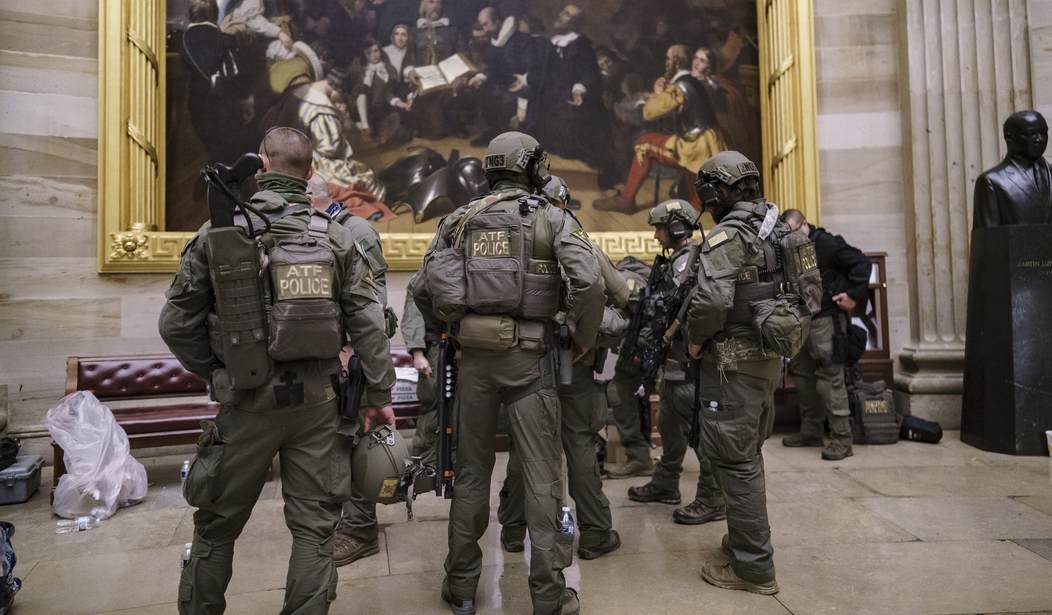Florida resident Graydon Young, 55, who is one of the 16 named Oathkeeper defendants charged in the most widely publicized indictment connected to the January 6 protests at the U.S. Capitol, entered pleas of guilty to two charges on Wednesday — “conspiracy” and “obstruction of an official proceeding.” It was the first guilty plea in the main conspiracy case brought by the Department of Justice against members of the group.
Another Oathkeeper member, Jon Ryan Schaffer, has also pleaded guilty in a separate case, but he was not named as a co-conspirator in the main case involving a large number of reputed Oathkeeper members. Schaffer has also agreed to cooperate with investigators and potentially testify against other defendants.
News reports of the hearing state that the government agreed to dismiss the four remaining counts against Young, and the two sides estimate that the sentencing guideline range that will likely apply to his case will call for a sentence of between 63 and 78 months. Based on Young’s agreement to cooperate, the Government may make a motion for a sentence reduction at the time of sentencing. The extent of any such recommendation is not yet known, and would not be binding on the judge.
The actual plea agreement is not yet available online. The language of the plea agreement will explain exactly which factual allegations in the Fourth Superseding Indictment Young has admitted to be true.
By virtue of his agreement, the government has at least one identified and confessed “conspirator” who it claims will be able to testify about other alleged co-conspirators, and by that testimony can establish that a conspiracy did, in fact, exist amongst and between the named defendants. This is always the initial hurdle in “proof” — getting past the place where you have only concerted activity but nothing more. The government claims to have captured a lot of communications between people, but Young will be able to describe other conversations that weren’t recorded by anyone.
The allegations in the indictment specific to Young are as follows:
The earliest “overt act” alleged in the indictment is a GoToMeeting call that took place involving several of the named conspirators on November 9, 2020. Young is not identified as being a participant in that call.
The first reference to Young alleges that he mailed an “application” to the Florida Chapter of the Oathkeepers on December 5, 2020, in which he wrote “Looking to get involved in helping…” That seems to eliminate Young from among the original cast of alleged organizers and creates a limited timeframe within which Young’s activities would be relevant — from Dec. 5, 2020, to Jan. 6, 2021.
The indictment alleges that on Dec. 19, Young wrote to a Facebook group: “Please check out Oath Keepers as a means to get more involved. Recruiting is underway. DM me if you want more info.”
The indictment alleges that on Dec. 26, Young wrote to a Florida company that conducts firearms training about scheduling a training session for four people in a “UTM Rifle Class”. The indictment alleges that “UTM” was a reference to “ultimate training munitions” — but doesn’t define that phrase further. That is an interesting omission since “UTM” involves non-lethal rounds — something like “blanks” — that allow “live-fire” training without endangering anyone participating.
The indictment does not allege that anyone ever attended this training, and given the fact that more than six months had passed when the Fourth Superseding Indictment was filed, I expect that if the government had evidence such training had taken place, it would have alleged that in the most recent indictment. The failure to do so after this much time is a strong indication that the training never happened. That leads to the question of “Why is the allegation included?”
The indictment alleges that on January 3, named co-defendant Steele sent a membership application to the Florida Oath Keepers based on instructions received from Young, who she identified as her brother. That same day Young and several other named defendants joined an invitation-only Signal group message titled “OK FL DC OP Jan 6”.
As of that date, a claim could plausibly be made that there was some form of “operation” planned for DC on January 6, and Young took an overt step with regard to that by joining the communications. But, the conspiracy alleged in the indictment is that the agreement among the conspirators was specifically to “corruptly interfere” with the official business of Congress in “certifying” the Electoral College votes.
The indictment alleges that Young and Steele — his sister — flew from Florida to North Carolina on January 4. On January 5, Young and Steele traveled with a group from North Carolina (listed in the indictment and “others known and unknown” but not referred to as “co-conspirators”) stopping at a Holiday Inn in Springfield, Virginia. Young paid for a room for two people for one night — likely for him and his sister.
The indictment alleges that at 2:26 pm on January 6, Young and the other named defendants “unlawfully entered the restricted Capitol grounds” without further description.
At 2:35, Young and the other named defendants joined with others in the “Stack” formation and moved towards an eastside entrance to the Capitol.
134. At the top of the steps, the Stack joined and then pushed forward alongside a mob that aggressively advanced towards the Columbus Doors at the central east entrance to the Capitol, assaulted the officers guarding the doors, threw objects and sprayed chemicals towards the officers and the doors, and pulled violently on the doors.
135. At 2:39 p.m., ISAACS joined the crowd in forcibly pushing against one of the Columbus Doors and the law enforcement officers guarding that door. Shortly thereafter, the Capitol doors were breached by the mob, and ISAACS entered the building.
136. Shortly after the mob breached the doors, CROWL, WATKINS, SANDRA PARKER, YOUNG, STEELE, KELLY MEGGS, CONNIE MEGGS, HARRELSON,HACKETT, DOLAN, and the others in the Stack forcibly entered the Capitol.
137. As they entered the Capitol, CROWL, WATKINS, SANDRA PARKER, YOUNG, STEELE, KELLY MEGGS, CONNIE MEGGS, HARRELSON, HACKETT, DOLAN, and the others in the Stack joined the larger mob in pushing past at least one law enforcement officer who was trying to stop them from breaching the Capitol building.
The indictment then continues to describe actions of “the mob” and “the stack,” mixing in the identities of the named defendants several times along the way.
The problem with this description is “the mob” isn’t a charged defendant, yet violent acts are attributed to “the mob.”
The indictment refers to things done by “the Stack” — which is meant to distinguish the named defendants from “the mob” — but even those descriptions describe “the Stack” as consisting of the named defendants and “others known and unknown.”
Proof at a trial would turn on what the videotape shows with regard to the individual actions of each person during the events in question. Witness descriptions of what “the mob” did or what “the Stack” did would not be sufficient.
As part of his guilty plea, Young will have made admissions to specific facts with respect to his conduct as agreed upon by him and the government. That factual statement will be part of the plea paperwork and will be signed by him. In addition, Judge Mehta reviewed those specific factual admissions in open court and asked Young to confirm orally that they were all true.
Once that paperwork is filed of the Court’s docket there will be a much clearer picture of what it is that Young has said to the prosecutors already about his involvement and the conduct of others as he witnessed it.
As noted, the parties estimate that Young is facing a sentence under the guidelines of between 63 and 78 months. The reports from the change of plea hearing about his cooperation stated that the prosecutors indicated they would be willing to consider a sentence reduction based on Young’s willingness to assist. This is a process that begins — it can only begin — with a motion filed with the Court by the prosecution that explains to the Court the assistance provided and the benefit to the government’s investigation. The government recommends a sentence reduction — may be up to as much as cutting it in half — but the final decision on whether to reduce the sentence and by how much rests with the Judge. This usually does not take place until the government’s investigation is finished.
I’ll have another story later when the change of plea documents are available and we know more about what it is Young has told the government up to this point. I expect we’ll shortly see a change of plea from his sister as well.














Join the conversation as a VIP Member